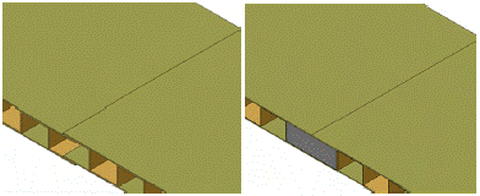Subproject B4: Bonding techniques for multi-material design with textile-reinforced composites
Supervision
Dr. rer. nat. Irene Jansen
Fraunhofer Institute for Material and Beam Technology
Winterbergstr. 28
01277 Dresden
Germany
Phone: +49 351 463-35210
Fax: +49 351 463-37755
Prof. Dr.-Ing. habil. Eckhard Beyer
TU Dresden
Institute of Manufacturing Technology
01062 Dresden
Germany
Phone: +49 351 463-31993
Fax: +49 351 463-37755
Abstract
The focus of this subproject is to develop bonding technologies based on laser and plasma techniques for manufacturing high resilient joints of textile reinforced composites with related and unrelated materials. Thereby, an additive-free material efficient thermoplastic joining technology will also be developed. This shall be conducted through laser based partial superficially fusing of the polypropylene matrix and the subsequently pressing onto unrelated joining partners.
The big potential in lightweight design of the new developed hybrid yarn textile thermoplastic (HGTT) composites can only be suitable for complex products using material appropriate joining technologies. Hereby, adhesive bonding techniques offer especially a plane and uniform load transmission.
Thus, the aim of the subproject is to develop adapted adhesive bonding technologies for the production of HGTT-composites in multi-material design with related and unrelated materials. These adhesive bonding technologies, that need to be redeveloped, are based on laser and plasma methods. Modifications on the surface need to be detected using suitable methods and correlated with experimentally determined adhesive strengths of such pretreated and bonded samples.
The cohesiveness of the used adhesives shall be specific adjusted through additive nano particles. Furthermore, using high-strength adhesives a combination of adhesive closure and form closure can be provided. The additional form closure can be achieved by laser supported inserting of angular holes or slots in parts to be joined. The adhesive yields in these micro structures and acts similar to a rivet connecting element after curing.
A further advantageous possibility for the production of HGTT-metal or HGTT-glass hybrid composites can be offered by tangential laser irradiation into small opened overlaps. Due to the local superficially fusing of the PP-matrix and the direct pressing onto the unrelated join partner, there is no need for adhesive.
In this application phase the joining technologies, which need to be developed, shall be experimentally verified by means of the load carrying behaviour of plane samples with single overlap. The technological cognitions, that were won, shall be transferred to the bonding of plane sandwich structures of spacer textiles. The production of the components will be realised by bonding the sandwich top layer on the web parallel edges as well as using an embedded aluminium profile (figure).
Figure: Design of the bonding zone of sandwich structures with overlap (left) and using an embedded profile (right)
In the concluding demonstrator phase the top layer of web orthogonal edges of plane and single bent sandwich structures shall be adhesive bonded together. The solution concepts, that need to be developed, will yield into the development of concept and technological transfer of the generic SFB demonstrator function integrative vehicle system carrier (FiF).

